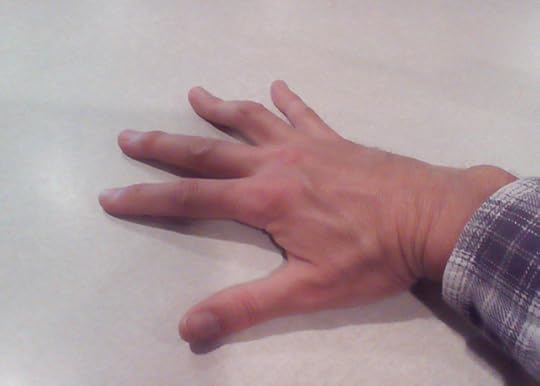Beating Arthritis
In the early 1990s, I started noticing sharp pains in my left foot. When I started work for Kitt Peak National Observatory in 1992 and had good insurance, I went to my doctor to have it checked out. After the podiatrist took a look at the X-ray, he looked up up at me and said, “You walked in here?” It turned out nearly a third of the ball joint on my left foot had eroded away due to arthritic inflammation.
I was sent to a rheumatologist who diagnosed me as having psoriatic arthritis, a somewhat rare form of arthritis that has the same root cause as the skin disease, psoriasis. Given that it was a chronic disease I came to accept there would never be a cure.  My doctor did a good job of slowing it down with methotrexate—a chemotherapy drug used to keep my own immune system from attacking my body. Over the years, I lost some hair and the arthritis continued to get worse. When I wrote my novel, The Pirates of Sufiro, I gave First Mate Roberts the same disease I had. Although the novel was set in the distant future, he was marooned on a distant world and had no more hope for a cure than I did. The exercise was therapeutic. It allowed me to imagine a character living a long a productive life despite a debilitating disease.
My doctor did a good job of slowing it down with methotrexate—a chemotherapy drug used to keep my own immune system from attacking my body. Over the years, I lost some hair and the arthritis continued to get worse. When I wrote my novel, The Pirates of Sufiro, I gave First Mate Roberts the same disease I had. Although the novel was set in the distant future, he was marooned on a distant world and had no more hope for a cure than I did. The exercise was therapeutic. It allowed me to imagine a character living a long a productive life despite a debilitating disease.
The disease went into remission soon after I moved to New Mexico in 1995. I stopped the methotrexate therapy with the blessing of a new doctor. There were still painful twinges, that reminded me it lingered in the background, but those were generally treatable with over-the-counter pain medication. However, the chronic nature of the disease reasserted itself big time in 2003. This time, I not only had pain in my feet but in my hands. I sought out a rheumatologist and he restarted the methotrexate therapy. He also helped me get shoe inserts that took the pressure off my toes, which helped tremendously. During this period of arthritic inflammation, the fourth finger of my right hand became swollen and suffered joint damage. That damage can be seen here.
Unfortunately, walking with a cane helped little. I was never in quite enough pain to require a wheelchair, though I admit I came awfully close. Because the arthritis wasn’t very visible, I never sought out a placard to park in any of the spots designated for disabled drivers. I never wanted to have an ignorant person shake their head disparagingly because they thought I was shamming my pain and taking a spot that someone else deserved—and frankly, bad as the arthritis pain was, I knew others who needed those spots more than I did. At this point in my life, I became even more convinced the arthritis would really disable me. This feeling was not helped when my rheumatologist pointed out that psoriatic arthritis has been known to inflame heart valve cartilage, creating even more problems.
In 2008, a new drug came on the market—Enbrel. My rheumatologist decided to give it a try and sure enough it helped. He suggested an aggressive treatment plan, essentially giving me the maximum recommended dosage. Over time, the arthritic inflammation subsided. After two years, he began to back off the dosages. Even with that, the arthritis remained in good control. Finally in late 2012, he gave me the option of stopping the medication. I felt good enough I agreed. Since then I’ve been seeing my rheumatologist annually and there has been no sign of the arthritis returning. I started exercising more regularly and lost some weight, which also helped. A little over a week ago at my regular visit, my doctor said he saw no reason to keep seeing me. It appeared the arthritis was not coming back anytime soon. However, I am welcome to call him if it does reappear.
Is the arthritis gone for good? Well, it is a chronic disease, so it could always rear its ugly head again. After all, it quieted down considerably for an eight-year period at one point. However for the moment, I feel pretty good—better than I did in the late 1990s—and I hope the story gives some hope for those who are suffering arthritic inflammation and fear it will never end. Of course, I can’t say that what worked (so far) for me will work for you. That’s something you would have to talk to your doctor about.
If you get angry because you see someone who appears to have “faked” a disability and has a placard or license plate indicating a disability when you don’t think they deserve it, please take a moment to reconsider. Some disabilities are invisible and you don’t know the pain that person is suffering or how it manifests.
Sadly, First Mate Roberts is stuck on the pages of my book, in a hover chair, suffering from his arthritis but he still gives me hope and helps me remember that disabled people can be productive and achieve great things. If you’d like to read his story, you can get the book for free at the Lachesis Publishing website.






